《概率论与数理统计》课程教学资源(教案讲义)Chapter 2 Conditional Probability
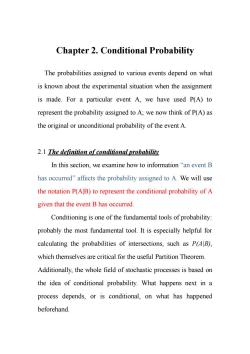
Chapter 2.Conditional Probability The probabilities assigned to various events depend on what is known about the experimental situation when the assignment is made.For a particular event A,we have used P(A)to represent the probability assigned to A;we now think of P(A)as the original or unconditional probability of the event A. 2.1 The definition of conditional probability In this section,we examine how to information"an event B has occurred"affects the probability assigned to A.We will use the notation P(AB)to represent the conditional probability of A given that the event B has occurred. Conditioning is one of the fundamental tools of probability: probably the most fundamental tool.It is especially helpful for calculating the probabilities of intersections,such as P(AB). which themselves are critical for the useful Partition Theorem. Additionally,the whole field of stochastic processes is based on the idea of conditional probability.What happens next in a process depends,or is conditional,on what has happened beforehand
Chapter 2. Conditional Probability The probabilities assigned to various events depend on what is known about the experimental situation when the assignment is made. For a particular event A, we have used P(A) to represent the probability assigned to A; we now think of P(A) as the original or unconditional probability of the event A. 2.1 The definition of conditional probability In this section, we examine how to information “an event B has occurred” affects the probability assigned to A. We will use the notation P(A|B) to represent the conditional probability of A given that the event B has occurred. Conditioning is one of the fundamental tools of probability: probably the most fundamental tool. It is especially helpful for calculating the probabilities of intersections, such as P(A|B), which themselves are critical for the useful Partition Theorem. Additionally, the whole field of stochastic processes is based on the idea of conditional probability. What happens next in a process depends, or is conditional, on what has happened beforehand

Dependent events.Suppose A and B are two events on the same sample space.There will often be dependence between A and B. This means that if we know that B has occurred,it changes our knowledge of the chance that A will occur Examplel:Toss a die once. Let event A=“geta6 Let event B=“get an even number'” If the die is fair,then P(A)=andP(B)=. However,if we know that B has occurred,then there is an increased chance that A has occurred: P(A occurs given that B has occurred)=3. (result o or We write (A given B)(A) Conditioning as reducing the sample space Example 2.The car survey in Examples of basic probability calculations also asked respondents which they valued more highly in a car:ease of parking,or style/prestige.Here are the responses: Male Female Total Prestige more important than parking 79 51 130 Prestige less important than parking 71 99 170 Total150150300 Suppose we pick a respondent at random from all those in the table
Dependent events. Suppose A and B are two events on the same sample space. There will often be dependence between A and B. This means that if we know that B has occurred, it changes our knowledge of the chance that A will occur. Example1: Toss a die once. However, if we know that B has occurred, then there is an increased chance that A has occurred: Conditioning as reducing the sample space Example 2. The car survey in Examples of basic probability calculations also asked respondents which they valued more highly in a car: ease of parking, or style/prestige. Here are the responses: Suppose we pick a respondent at random from all those in the table
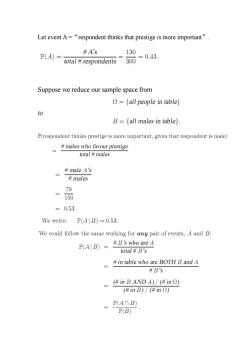
Let event A="respondent thinks that prestige is more important" #A's 130 P(A)= total#respondents300 =0.43. Suppose we reduce our sample space from =fall people in table to B=fall males in table F(respondent thinks prestige is more important,given that respondent is male) males who favour prestige total males = male A's males 79 二16而 =0.53 We write: P(AB)=0.53 We could follow the same working for any pair of events,A and B: P(AB)= #B's who are A total B's = in table who are BOTH B and A #B's (#in B AND A)/(#in) (#inB)/(#in2) F(AnB) P(B)
Let event A =“respondent thinks that prestige is more important”. Suppose we reduce our sample space from
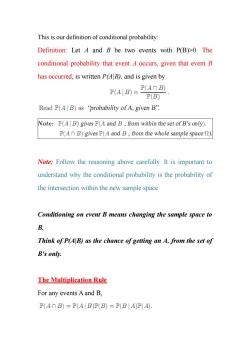
This is our definition of conditional probability: Definition:Let 4 and B be two events with P(B)>0.The conditional probability that event 4 occurs,given that event B has occurred,is written P(A B),and is given by P(A|B)= P(A0B) P(B) Read P(A B)as "probability of A,given B". Note:P(A B)gives P(A and B,from within the set of B's only). P(AnB)gives P(A and B,from the whole sample space Note:Follow the reasoning above carefully.It is important to understand why the conditional probability is the probability of the intersection within the new sample space Conditioning on event B means changing the sample space to 中 Think of P(A B)as the chance of getting an A,from the set of B's only. The Multiplication Rule For any events A and B, P(AB)=P(A B)P(B)=P(B A)P(A)
This is our definition of conditional probability: Definition: Let A and B be two events with P(B)>0. The conditional probability that event A occurs, given that event B has occurred, is written P(A|B), and is given by Note: Follow the reasoning above carefully. It is important to understand why the conditional probability is the probability of the intersection within the new sample space Conditioning on event B means changing the sample space to B. Think of P(A|B) as the chance of getting an A, from the set of B's only. The Multiplication Rule For any events A and B

New statement of the Partition Theorem The Law of Total Probability) The Multiplication Rule gives us a new statement of the Partition Theorem (Total Probability Theorem) If B,...,Bm partition S,then for any event A, F(A)=SP(AB)=>P(A B:)F(B). Both formulations of the Partition Theorem are very widely used, but especially the conditional formulation ∑1P(AB)P(B). Examples of conditional probability and partitions Example 3.A news magazine publishes three columns entitled"Art"(A). "Books"(B),and"Cinema"(C).Reading habits of a randomly selected reader with respect to these columns are Read A BCAOBAOC BOC AOBOC regularly Probability0.140.230.370.080.090.130.05 We thus have P(4IB)-P(4B)_0.08 P90230348 P4BU0=P4n8UC》_004+005+003.0255 P(BUC) 0.47 P(Alreads atr least one)-P(ALAUBUC)-(A(BC) P(AUBUC) “n40G-85-02c P(A P4U81C=P4UnC》.004+0o5+008-0459 P(C) 0.37
New statement of the Partition Theorem (The Law of Total Probability) The Multiplication Rule gives us a new statement of the Partition Theorem (Total Probability Theorem) Both formulations of the Partition Theorem are very widely used, but especially the conditional formulation Examples of conditional probability and partitions Example 3. A news magazine publishes three columns entitled “Art”(A), “Books”(B), and “Cinema”(C). Reading habits of a randomly selected reader with respect to these columns are Read regularly A B C A B A C B C A B C Probability 0.14 0.23 0.37 0.08 0.09 0.13 0.05 We thus have 0.459 0.37 0.04 0.05 0.08 ( ) (( ) )) ( | ) 0.286 0.49 0.14 ( ) ( ) ( ) ( ( )) ( | ) ( | ) 0.255 0.47 0.04 0.05 0.03 ( ) ( ( )) ( | ) 0.348 0.23 0.08 ( ) ( ) ( | ) P C P A B C P A B C P A B C P A P A B C P A A B C P A reads at least one P A A B C P B C P A B C P A B C P B P A B P A B
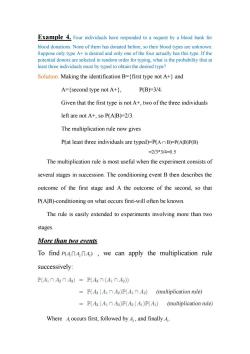
Example 4.Four individuals have responded to a request by a blood bank for blood donations.None of them has donated before,so their blood types are unknown Suppose only type A+is desired and only one of the four actually has this type.If the potential donors are selected in random order for typing,what is the probability that at least three individuals must by typed to obtain the desired type? Solution.Making the identification B=(first type not A+)and A={second type not A+),P(B)=3/4. Given that the first type is not A+,two of the three individuals left are not A+,so P(AB)=2/3 The multiplication rule now gives P(at least three individuals are typed)=P(AB)=P(AB)P(B) =2/3*3/4-0.5 The multiplication rule is most useful when the experiment consists of several stages in succession.The conditioning event B then describes the outcome of the first stage and A the outcome of the second,so that P(A|B)-conditioning on what occurs first-will often be known. The rule is easily extended to experiments involving more than two stages. More than two events To find P(),we can apply the multiplication rule successively: P(A10A20A3)=P(A3n(A042)) =P(A3|AA2)P(A1A2)(multiplication rule) =P(A3|A A2)P(A2 A)P(A1)(multiplication rule) Where 4 occurs first,followed by 4,and finally 4
Example 4. Four individuals have responded to a request by a blood bank for blood donations. None of them has donated before, so their blood types are unknown. Suppose only type A+ is desired and only one of the four actually has this type. If the potential donors are selected in random order for typing, what is the probability that at least three individuals must by typed to obtain the desired type? Solution. Making the identification B={first type not A+} and A={second type not A+}, P(B)=3/4. Given that the first type is not A+, two of the three individuals left are not A+, so P(A|B)=2/3. The multiplication rule now gives P(at least three individuals are typed)=P(A B)=P(A|B)P(B) =2/3*3/4=0.5 The multiplication rule is most useful when the experiment consists of several stages in succession. The conditioning event B then describes the outcome of the first stage and A the outcome of the second, so that P(A|B)-conditioning on what occurs first-will often be known. The rule is easily extended to experiments involving more than two stages. More than two events To find 1 2 3 P A A A ( ) , we can apply the multiplication rule successively: Where A1 occurs first, followed by A2 , and finally A3

Example 5.For the blood typing experiment of the above example. P(third type is A+)=P(third is first isn'tsecond isn't) .P(second isn't first isn't).P(first isn't) Example 6:A box contains w white balls and r red balls.Draw 3 balls without replacement.What is the probability of getting the sequence white,red,white? Solution: P(Win R2nW3)=P(Wi)P(R2|Wi)P(W3|R2nWi) (4)x(+)x() Example 7.Tom gets the bus to campus every day.The bus is on time with probability ,and late with probability0.4. The sample space can be written as n fbus journeysf. We can formulate events as follows:T=“on time”;L=“late” From the information given,the events have probabilities: PT=0.6;PL)=0.4 Question(a)Do the events T and L form a partition of the sample space? Explain why or why not. Solution. Yes. They cover all possible journeys (probabilities sum to 1),and there is no overlap in the events by definition
Example 5. For the blood typing experiment of the above example, 0.25 4 1 4 3 3 2 2 1 (sec ' | ' ) ( ' ) ( ) ( | ' sec ' ) P ond isn t first isn t P first isn t P third type is A P third is first isn t ond isn t Example 6: A box contains w white balls and r red balls. Draw 3 balls without replacement. What is the probability of getting the sequence white, red, white? Solution: Example 7. Tom gets the bus to campus every day. The bus is on time with probability 0.6, and late with probability 0.4. The sample space can be written as We can formulate events as follows: T = “on time”; L = “late”. From the information given, the events have probabilities: P(T) = 0.6 ; P(L) = 0.4 Question(a) Do the events T and L form a partition of the sample space? Explain why or why not. Solution. Yes. They cover all possible journeys (probabilities sum to 1), and there is no overlap in the events by definition
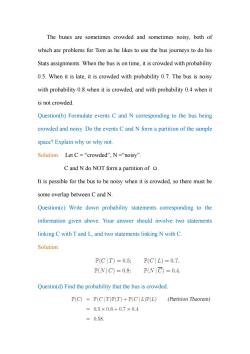
The buses are sometimes crowded and sometimes noisy,both of which are problems for Tom as he likes to use the bus journeys to do his Stats assignments.When the bus is on time,it is crowded with probability 0.5.When it is late,it is crowded with probability 0.7.The bus is noisy with probability 0.8 when it is crowded,and with probability 0.4 when it is not crowded. Question(b)Formulate events C and N corresponding to the bus being crowded and noisy.Do the events C and N form a partition of the sample space?Explain why or why not. Solution.LetC=“crowded,N=“noisy' C and N do NOT form a partition of It is possible for the bus to be noisy when it is crowded,so there must be some overlap between C and N. Question(c)Write down probability statements corresponding to the information given above.Your answer should involve two statements linking C with T and L,and two statements linking N with C. Solution. P(C1T)=0.5: PC1L)=0.7. P(N1C)=0.8:P(N1C=0.4. Questin(d)Find the probability that the bus is crowded. P(C)=P(C|T)P(T)+P(C L)P(L)(Partition Theorem) =0.5×0.6+0.7×0.4 =0.58
The buses are sometimes crowded and sometimes noisy, both of which are problems for Tom as he likes to use the bus journeys to do his Stats assignments. When the bus is on time, it is crowded with probability 0.5. When it is late, it is crowded with probability 0.7. The bus is noisy with probability 0.8 when it is crowded, and with probability 0.4 when it is not crowded. Question(b) Formulate events C and N corresponding to the bus being crowded and noisy. Do the events C and N form a partition of the sample space? Explain why or why not. Solution. Let C = “crowded”, N =“noisy”. C and N do NOT form a partition of . It is possible for the bus to be noisy when it is crowded, so there must be some overlap between C and N. Question(c) Write down probability statements corresponding to the information given above. Your answer should involve two statements linking C with T and L, and two statements linking N with C. Solution. Questin(d) Find the probability that the bus is crowded
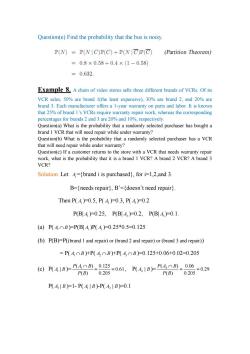
Question(e)Find the probability that the bus is noisy P(N)=P(N |C)P(C)+P(N C)P(C)(Partition Theorem) =0.8×0.58+0.4×(1-0.58) =0.632 Example 8.A chain of video stores sells three different brands of VCRs.Of its VCR sales,50%are brand 1(the least expensive),30%are brand 2,and 20%are that 25%of brand 1's VCRsr require v warranty repair work, hereas the corresponding percentages for brands 2 and 3 are 20%and 10%,respectively Question(a)What is the probability that a randomly selected purchaser has bought a brand 1 VCR that will need repair while under warranty? Question(b)What is the probability that a randomly selected purchaser has a VCR work,what is the probability that it is a brand 1 VCR?A brand 2 VCR?A brand 3 VCR? Solution.Let ,={brand i is purchased),for i=1,2,and 3. B=(needs repair),B'=(doesn't need repair) Then P(A0.5,P(A2)0.3,P(A)0.2 PBl4=0.25,P(BA)=0.2,PB4)=0.1 (a)P(4nB)=P(BlA)P(4)=0.25*0.5=0.125 (b)P(B)=P((brand I and repair)or(brand 2 and repair)or (brand 3 and repair)) =P(4nB+P(4nB+P(4,⌒B)=0.125+0.06+0.02-=0.205 日41eA-8-06,41nA0-8器-029 PB)0.205 P(41B)=1-P(41B)-P(421B)=0.1
Question(e) Find the probability that the bus is noisy. Example 8. A chain of video stores sells three different brands of VCRs. Of its VCR sales, 50% are brand 1(the least expensive), 30% are brand 2, and 20% are brand 3. Each manufacturer offers a 1-year warranty on parts and labor. It is known that 25% of brand 1’s VCRs require warranty repair work, whereas the corresponding percentages for brands 2 and 3 are 20% and 10%, respectively. Question(a) What is the probability that a randomly selected purchaser has bought a brand 1 VCR that will need repair while under warranty? Question(b) What is the probability that a randomly selected purchaser has a VCR that will need repair while under warranty? Question(c) If a customer returns to the store with a VCR that needs warranty repair work, what is the probability that it is a brand 1 VCR? A brand 2 VCR? A brand 3 VCR? Solution. Let Ai ={brand i is purchased}, for i=1,2,and 3. B={needs repair}, B’={doesn’t need repair}. Then P( A1 )=0.5, P( A2 )=0.3, P( A3 )=0.2 P(B| A1 )=0.25, P(B| A2 )=0.2, P(B| A3 )=0.1. (a) P( A1 B )=P(B| A1 )P( A1 )=0.25*0.5=0.125 (b) P(B)=P((brand 1 and repair) or (brand 2 and repair) or (brand 3 and repair)) = P( A1 B )+P( A2 B )+P( A3 B )=0.125+0.06+0.02=0.205 (c) P( A1 | B )= 0.61 0.205 0.125 ( ) ( ) 1 P B P A B , P( A2 | B )= 0.29 0.205 0.06 ( ) ( ) 2 P B P A B P( A3 | B )=1- P( A1 | B )-P( A2 | B )=0.1

2.2 Statistical Independence Two events A and B are statistically independent if the occurrence of one does not affect the occurrence of the other. This means P(A B)=P(A)and P(B A)=P(B). Now F(AIB)=P(An B) P(B) so if P(A B)=P(A)then P(AnB)=P(A)x P(B). We use this as our definition of statistical independence. Definition:Events A and B are statistically independent if P(A∩B)=P(A)P(B). For more than two events,we say: Definition:Events A1,A2....,An are mutually independent if P(A10A0...nAn)=P(A1)P(A2)...P(An),AND the same multiplication rule holds for every subcollection of the events too. Eg.events A,A2,A3.A are mutually independent if i)P(AnA)=P(A)P(A)for all i,j with i≠j: AND ii)P(AAjA)=P(A)P(Aj)P(Ax)for all i,j.k that are all different: AND iii)P()=P(A)P(A2)P(A3)P(A). Statistical independence for calculating the probability of an intersection We usually have two choices
2.2 Statistical Independence Two events A and B are statistically independent if the occurrence of one does not affect the occurrence of the other. We use this as our definition of statistical independence. For more than two events, we say: Statistical independence for calculating the probability of an intersection We usually have two choices
按次数下载不扣除下载券;
注册用户24小时内重复下载只扣除一次;
顺序:VIP每日次数-->可用次数-->下载券;
- 《概率论与数理统计》课程教学资源(教案讲义)Chapter 1 Random Events and Probability.pdf
- 《概率论与数理统计》课程教学资源(教案讲义)概率论与数理统计教学大纲.pdf
- 《实分析与傅里叶分析》课程教学资源(讲义)实分析与傅里叶分析(英文版)Introduction to Real Analysis and Fourier Analysis,RA.pdf
- 《高等数学》课程教学资源(书籍文献)高等数学参考书籍《古今数学思想》电子版(2/4)第二册.pdf
- 《高等数学》课程教学资源(书籍文献)高等数学参考书籍《古今数学思想》电子版(4/4)第四册.pdf
- 《高等数学》课程教学资源(书籍文献)高等数学参考书籍《古今数学思想》电子版(3/4)第三册.pdf
- 《高等数学》课程教学资源(书籍文献)高等数学参考书籍《古今数学思想》电子版(1/4)第一册.pdf
- 微积分发展史(讲义)微积分思想的产生与发展历史.pdf
- 上海交通大学:《概率论与数理统计》课程教学资源(课件讲义)第八章 假设检验 8.2 单个正态总体的参数检验.pdf
- 上海交通大学:《概率论与数理统计》课程教学资源(课件讲义)第八章 假设检验 8.1 假设检验的基本概念.pdf
- 上海交通大学:《概率论与数理统计》课程教学资源(课件讲义)第七章 参数估计 7.3 区间估计.pdf
- 上海交通大学:《概率论与数理统计》课程教学资源(课件讲义)第七章 参数估计 7.2 点估计的评价标准.pdf
- 上海交通大学:《概率论与数理统计》课程教学资源(课件讲义)第七章 参数估计 7.1 点估计法.pdf
- 上海交通大学:《概率论与数理统计》课程教学资源(课件讲义)第六章 数理统计的基本概念 6.2 抽样分布.pdf
- 上海交通大学:《概率论与数理统计》课程教学资源(课件讲义)第六章 数理统计的基本概念 6.1 基本概念.pdf
- 上海交通大学:《概率论与数理统计》课程教学资源(课件讲义)第五章 大数定律与中心极限定理 5.2 中心极限定理.pdf
- 上海交通大学:《概率论与数理统计》课程教学资源(课件讲义)第五章 大数定律与中心极限定理 5.1 大数定律.pdf
- 上海交通大学:《概率论与数理统计》课程教学资源(课件讲义)第四章 随机变量的数字特征 4.4 矩和协方差矩阵.pdf
- 上海交通大学:《概率论与数理统计》课程教学资源(课件讲义)第四章 随机变量的数字特征 4.3 协方差及相关系数.pdf
- 上海交通大学:《概率论与数理统计》课程教学资源(课件讲义)第四章 随机变量的数字特征 4.2 方差.pdf
- 《数理统计》课程PPT教学课件(讲稿)离散随机变量及分布律.ppt
- 《数理统计》课程PPT教学课件(讲稿)常见的连续性随机变量的分布.ppt
- 《数理统计》课程PPT教学课件(讲稿)第一章 统计推断准备.ppt
- 《线性代数》课程教学资源(书籍文献)线性椭圆型方程 Linear Elliptic Equations.pdf
- 上海交通大学:《矩阵论》课程教学资源(讲义)CHAPTER 00.pdf
- 上海交通大学:《矩阵论》课程教学资源(讲义)CHAPTER 01.pdf
- 上海交通大学:《矩阵论》课程教学资源(讲义)CHAPTER 02.pdf
- 上海交通大学:《矩阵论》课程教学资源(讲义)CHAPTER 03.pdf
- 上海交通大学:《矩阵论》课程教学资源(讲义)CHAPTER 04.pdf
- 上海交通大学:《矩阵论》课程教学资源(讲义)CHAPTER 05.pdf
- 上海交通大学:《矩阵论》课程教学资源(讲义)CHAPTER 06.pdf
- 上海交通大学:《矩阵论》课程教学资源(讲义)CHAPTER 07.pdf
- 上海交通大学:《矩阵论》课程教学资源(讲义)CHAPTER 08.pdf
- 概率论与数理统计课程教学大纲 Probability and statistics.pdf
- 延安大学:《概率论与数理统计》课程授课教案(打印版)概率论与数理统计 Probability Theory and Mathematical Statistics(任课教师:吕佳).pdf
- 西北师范大学:数学与统计学院数学与应用数学专业学院平台学科必修课程教学大纲汇编.pdf
- 西北师范大学:数学与统计学院数学与应用数学专业专业平台必修课程教学大纲汇编.pdf
- 西北师范大学:数学与统计学院数学与应用数学专业专业平台任选课程教学大纲汇编.pdf
- 西北师范大学:数学与统计学院信息与计算科学专业专业平台必修课程教学大纲汇编.pdf
- 西北师范大学:数学与统计学院信息与计算科学专业专业平台任选课程教学大纲汇编.pdf
